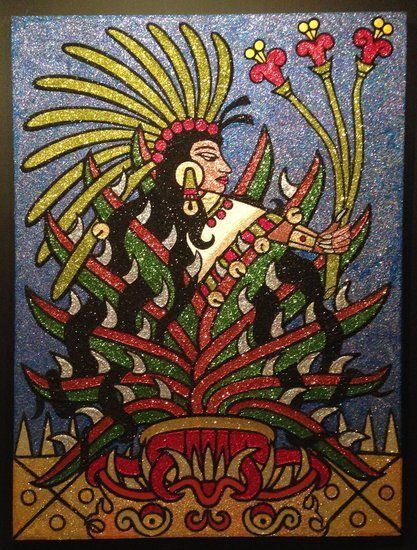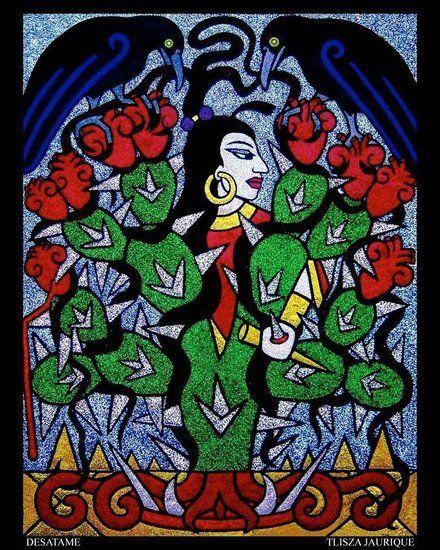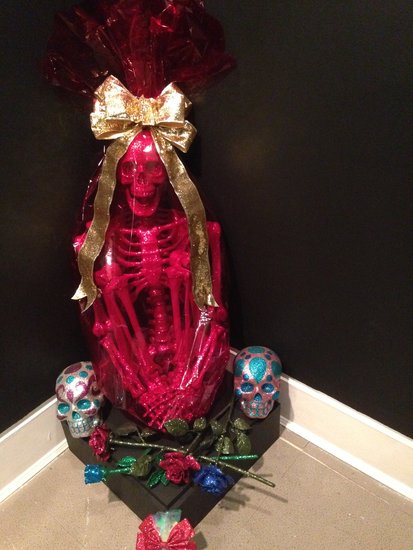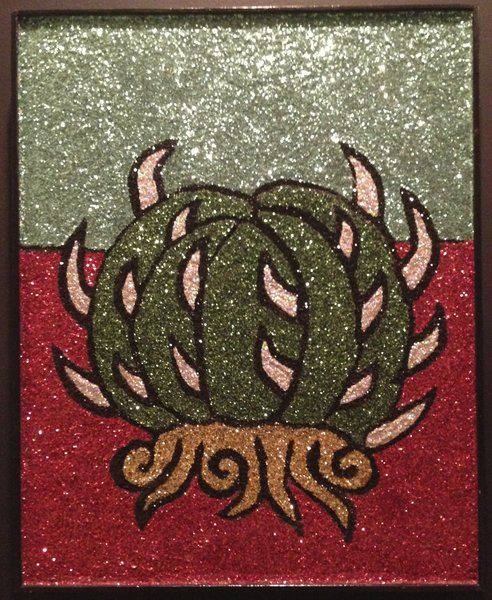[Rachel discusses how Tlisza Jaurique’s combination of traditional and modern cultural tropes, plus the use of glitter, gives the artist’s work meaning and relevance. –the Artblog editors]
The iconography is strikingly familiar, but the execution comes with a twist. Tlisza Jaurique takes traditional Mexican imagery–Aztec motifs, local fauna, nationalist colors–but mixes in contemporary nuances. Her main ingredient? Glitter.

The Madonna takes center stage in Taller Puertorriqueño’s current exhibition, A Contemporary Madonna Counterpoint: Mexico & Puerto Rico. Jaurique offers the Mexican perspective, while Philadelphia artist and musician Daniel de Jesús offers a Puerto Rican-inspired view. While de Jesús’ influences from colonial Latin American art, Japanese anime, and fashion certainly offer an interesting interpretation of the contemporary Madonna figure, it is Jaurique’s work that steals the show.
Born in Phoenix, Arizona, Jaurique is heavily influenced by her cultural identity. Her roots trace back to Mexico’s indigenous people (her grandmother was from the Nahua and Yaqui communities). Consequently, traditional Mexican celebrations, such as the Day of the Dead and the Feast Day of the Virgin of Guadalupe, are prominent in her works’ blend of topography, painting, and sculpture.

A female figure takes center stage in her large 2005 piece “Desátame,” (Unravel Me). In black graphic outline, inlaid with bright color fields of glitter, the figure appears in the center of the composition. Her face is indigenous rather than Guadalupe’s standard mestizo, but the compositional structure is still reminiscent of Mexico’s iconic Virgin. Two black ravens grab hold of the figure’s hair–she herself is surrounded by sacred hearts and cacti. While the work’s title presupposes vulnerability, the figure remains swaddled in sharp, mythical objects that symbolize protection and veneration. This complex layering and subtle iconography produces a stunning interpretation of a contemporary Madonna that still remains rooted in the past.
Critiquing contemporary kitsch

Some of Jaurique’s other works play with different components of Mexican folk art. Skulls reference the Day of the Dead, while also inevitably reflecting contemporary politics. This is evident in the work “Mummy Bundle,” in which a corner altar displays a full skeleton wrapped in bright red plastic. Glittering flowers and painted skulls are placed at the skeleton’s feet as offerings. Here, Jaurique brilliantly captures the vibrancy of folk art and celebration of indigenous traditions, while also critiquing the consequences of contemporary kitsch.

This idea is precisely what makes Jaurique’s work successful: her pieces carry the spirit of the traditional while retaining the urgency of the contemporary. The politics are often so subtle that they could very well be indecipherable, but their presence cannot be avoided once recognized. Correlations between Chicana/o activism, border issues, and collective identity become central themes, cryptically communicated through speech scrolls, cacti, and Sacred Hearts.

This brings us back to Jaurique’s main ingredient–glitter. A material associated with craft, innocence, and Hobby Lobby, glitter does not immediately seem to match the strong figures and symbols central in the artist’s work. Yet glitter has two important characteristics that underscore Jaurique’s use of the material: accessibility and reflection. Utilizing glitter along with circular mirrors throughout her pieces, the artist directly empowers the materials as sources for reflection–both back onto the self, and onto the other. As viewers, we are directly invited into the work, regardless of our knowledge or connection with the subject at hand. In this way, the artist activates glitter’s accessibility. This layering of material and symbolism produces a body of work that is remarkably celebratory and strikingly original.
A Contemporary Madonna Counterpoint: Mexico & Puerto Rico is on view at Taller Puertorriqueño’s Lorenzo Homar Gallery through April 12, 2014.









